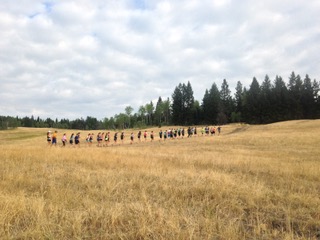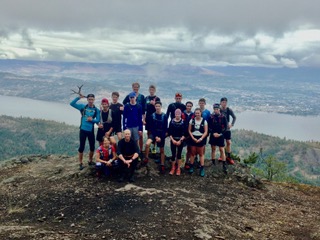Ross McKinnon, Physiotherapist. Kelowna Manual Therapy Centre

Nordic athletes will be transitioning to running over the next few weeks as the snow disappears and/or the ski trails shut down. Overuse injuries from running were the most commonly reported injuries in British Columbia Ski Team athletes in injury surveys completed in 2018 and 2019. The vast majority of these overuse injuries occurred in the General Preparation phase of the yearly training plan.
Ski coaches and athletes can help reduce the incidence of injury by following a few guidelines.
Training Load Management
Proper training involves gradually increasing the training load, combined with adequate rest to allow the body to adapt to the increased demands. Overuse injuries occur as there is more stress and strain on the body than it can handle. In other words, the body’s musculoskeletal system’s ability to adapt to load is exceeded. This excessive load can be any combination of increased volume, increased intensity and/or too little rest in between running sessions.
Athletes need to be educated on taking care of, and listening to, their body and following the ’24 hour rule’. An increase in pain longer than 24 hours after training would be a warning sign of excessive load. If the pain does not settle within 24 hours then the athlete needs to reduce the training load. Working through post exercise muscular soreness, though mildly uncomfortable, is okay and has been proven to have no negative effect. More concerning would be tendon, joint or muscular pain that would be described as sharp or stabbing.

Athletes should be educated on gradually increasing their running volume and or intensity. Starting off, it would be beneficial not to run on back to back training days. Thankfully cross country ski training involves a variety of activities which is a great way to vary the training load and minimize stress on the musculoskeletal system. Cross training has been shown to reduce the injury prevalence in athletes.
Work on Running Technique
- Increase running cadence (180-220 steps per minute) to decrease ‘over striding’ and minimize ground reaction forces. Foot strike should be only slightly ahead of the body. Athletes can focus on increasing cadence or decreasing stride length to see what works best for them.
- Run ‘softly’, minimizing foot impact sounds. One drill would involve running in socks without shoes on a rubber track to help ‘feel’ how to minimize impact.
- Minimize vertical oscillation, i.e excessive up and down motion
- Lean slightly forward from the ankles with a tall chest.
- Heel strike vs forefoot strike is debatable. Athletes should do what is natural but focus on a soft landing with a high cadence as mentioned above.
- Practice downhill running on trails to minimize loading and reduce the chance of injury. (Salomon TV: How to downhill Run https://www.youtube.com/watch?v=YLScRlispoo)
General
- Start with running on softer surfaces like trails rather than roads to minimize impact. Gradually work up to hill running.
- Athletes should consider purchasing new shoes at the start of the season and begin to rotate shoes, alternating pairs with each running session. This has been backed by research showing a 39% reduction in running injuries by rotating through 2 or more pairs of shoes.
- Some running over the winter is beneficial to maintain running ‘fitness’.
- If athletes continue to complain of pain or soreness it would be best for athletes to consult with a local physiotherapist for advice and treatment.
Ross McKinnon is a local ski coach and registered Physiotherapist in Kelowna, BC. He is an owner of Kelowna Manual Therapy Centre. He is the team physiotherapist for Team Telemark and is a consultant to the BC Ski Team. Ross has a special interest in preventing injuries and improving performance in nordic athletes.



